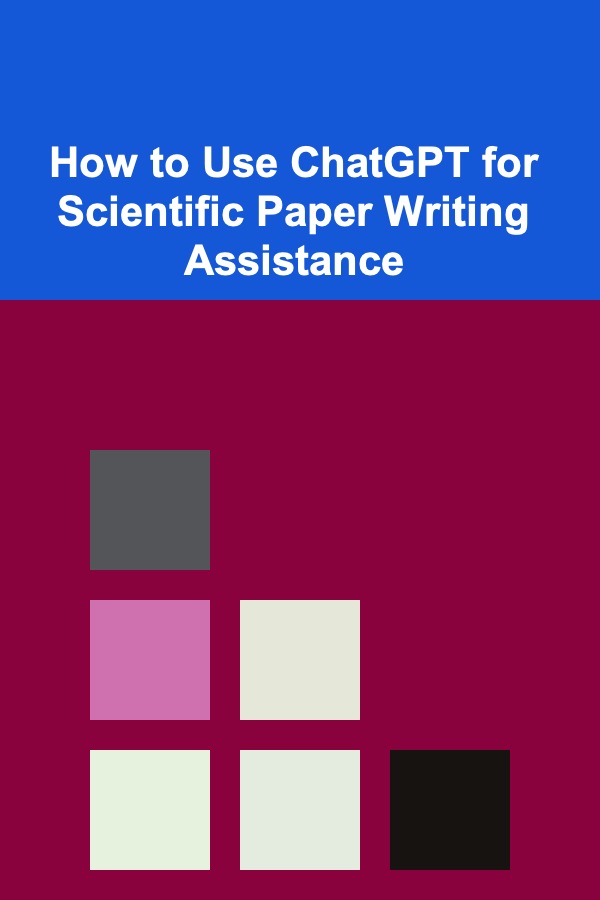
How to Use ChatGPT for Scientific Paper Writing Assistance
ebook include PDF & Audio bundle (Micro Guide)
$12.99$11.99
Limited Time Offer! Order within the next:

Scientific writing is a crucial skill for researchers, students, and professionals in the field of science. It requires clear and concise communication of complex ideas, experiments, and results. However, writing a scientific paper can be a daunting task, often involving extensive research, analysis, and multiple revisions. This is where AI tools, like ChatGPT, can play a transformative role in assisting with scientific paper writing.
In this article, we will explore how ChatGPT can be leveraged to aid in various aspects of scientific paper writing. From generating ideas and drafting sections to improving language and providing formatting tips, ChatGPT has the potential to streamline the writing process and improve the quality of scientific papers.
What is ChatGPT?
ChatGPT, developed by OpenAI, is a language model that uses deep learning techniques to generate human-like text based on the input provided by the user. It has been trained on vast amounts of text data, which enables it to understand and generate responses that mimic human conversation and writing. Although it is not a substitute for domain-specific expertise, ChatGPT is an invaluable tool for assisting with the language and structure of scientific writing.
The Role of ChatGPT in Scientific Paper Writing
Scientific papers are typically structured into several key sections, including the title, abstract, introduction, methodology, results, discussion, conclusion, and references. Each of these sections requires careful attention to detail, precision, and clarity. ChatGPT can assist in all stages of writing by offering suggestions, generating drafts, improving readability, and helping with language consistency.
Here is how ChatGPT can assist in writing each section of a scientific paper:
1. Generating the Title
The title is one of the most critical aspects of a scientific paper because it serves as the first impression of your research. A good title should be concise, descriptive, and informative. It should accurately reflect the content and focus of the paper, while also being engaging enough to attract readers.
How ChatGPT Can Help:
ChatGPT can help you brainstorm potential titles based on the main topic or research question of your paper. You can provide a prompt like:
- "Suggest a concise and informative title for a paper on the effects of climate change on coral reef ecosystems."
- "Generate three potential titles for a paper on machine learning algorithms in healthcare."
ChatGPT will analyze the keywords and suggest titles that align with the content, ensuring that they are both relevant and precise.
2. Writing the Abstract
The abstract is a brief summary of the entire paper. It should clearly communicate the purpose, methodology, results, and conclusions of the research. Writing a concise and informative abstract is often challenging, as it requires distilling complex ideas into a few sentences.
How ChatGPT Can Help:
ChatGPT can assist in writing the abstract by summarizing the key points of the paper. If you provide the main findings and conclusions of your research, ChatGPT can generate a well-structured abstract that effectively conveys the essence of the paper.
For example, you can input:
- "Write a 200-word abstract for a paper that investigates the relationship between air pollution and respiratory diseases in urban areas."
ChatGPT will generate a draft that succinctly summarizes your research, which can be further refined as needed.
3. Crafting the Introduction
The introduction provides the background information necessary to understand the research question. It should outline the problem, the research gap, the objectives, and the significance of the study. A well-written introduction sets the stage for the rest of the paper.
How ChatGPT Can Help:
ChatGPT can help by generating an outline or draft of the introduction based on the information you provide. By inputting key details about the problem, previous research, and your research objectives, ChatGPT can produce a coherent introduction that contextualizes the study.
For example, input the following prompt:
- "Write an introduction for a paper on the impact of deforestation on biodiversity in tropical rainforests."
ChatGPT will provide a draft introduction that you can use as a foundation for further refinement.
4. Developing the Methodology
The methodology section outlines the research design, procedures, data collection methods, and tools used in the study. This section should be detailed and precise, as it enables other researchers to replicate the study. Writing a clear methodology is essential for scientific credibility.
How ChatGPT Can Help:
ChatGPT can assist in structuring the methodology section. You can input specific details about your research design, such as the type of study (e.g., experimental, observational), the methods of data collection (e.g., surveys, interviews, laboratory tests), and any equipment or software used. ChatGPT can then generate a draft methodology section based on the information you provide.
For example, input:
- "Write the methodology section for an experimental study investigating the effects of light on plant growth, using a controlled laboratory setup."
ChatGPT will draft a clear and detailed methodology that aligns with the experimental design.
5. Analyzing the Results
The results section presents the findings of the study, often including tables, graphs, and statistical analyses. This section should be objective and focused on the data, avoiding any interpretation or conclusions.
How ChatGPT Can Help:
ChatGPT can help by analyzing and summarizing the results you provide. If you have raw data or statistical findings, you can describe them to ChatGPT, and it can assist in presenting the results in a clear and coherent manner. It can also help describe trends or patterns in the data, ensuring that the language is precise and professional.
For example, input:
- "Describe the results of an experiment where the temperature of water increased by 5°C every 10 minutes, and the growth of bacteria was measured over a 60-minute period."
ChatGPT will generate a draft of the results section, which can be further refined with specific details such as tables or figures.
6. Writing the Discussion
The discussion interprets the results in the context of the research question and compares them to previous studies. It explores the implications of the findings and suggests directions for future research. This section requires critical thinking and a deep understanding of the subject matter.
How ChatGPT Can Help:
ChatGPT can assist in writing the discussion section by generating ideas for interpreting the results. You can input the key findings and ask ChatGPT to suggest possible explanations or comparisons with existing research. Additionally, it can help draft sentences that explore the significance of the findings and propose future research directions.
For example, input:
- "Discuss the implications of the finding that plant growth increased by 10% when exposed to artificial light, compared to natural light."
ChatGPT will generate a discussion that analyzes the results in light of existing literature and highlights the relevance of the findings.
7. Concluding the Paper
The conclusion summarizes the key findings, highlights the significance of the research, and offers recommendations or potential areas for future work. A strong conclusion reinforces the main points and provides a sense of closure.
How ChatGPT Can Help:
ChatGPT can help draft a conclusion that succinctly summarizes the main findings and their implications. You can input the key results and the broader impact of your research, and ChatGPT can generate a well-rounded conclusion that ties together the entire paper.
For example, input:
- "Write a conclusion for a paper that investigates the effects of urbanization on air quality and public health."
ChatGPT will summarize the findings and provide suggestions for future research or action.
8. Improving Language and Readability
One of the main strengths of ChatGPT is its ability to improve the clarity and readability of text. Scientific writing must be precise, but it should also be accessible and engaging. ChatGPT can help by suggesting improvements to sentence structure, grammar, and style.
How ChatGPT Can Help:
You can input sections of your paper and ask ChatGPT to enhance the language. For instance, you might prompt:
- "Improve the readability of the following paragraph on the methodology."
- "Rewrite this sentence to make it clearer and more concise."
ChatGPT will refine the text, ensuring that the language is appropriate for a scientific audience.
9. Formatting and Citation Assistance
Proper formatting is essential in scientific writing. Different journals and conferences have specific formatting guidelines, such as referencing styles (APA, MLA, Chicago, etc.) and section headings. ChatGPT can assist with formatting tips and provide guidance on citation styles.
How ChatGPT Can Help:
ChatGPT can help with citation formatting by providing examples of proper citations in different styles. You can input the reference information, and ChatGPT can generate the correct format for your bibliography or reference list.
For example:
- "Generate an APA citation for the following book: 'Introduction to Quantum Physics' by John Doe, published in 2015."
ChatGPT will output the correct citation format.
Conclusion
ChatGPT is a powerful tool that can greatly assist in the process of writing a scientific paper. From generating titles and abstracts to drafting detailed sections of the paper, improving readability, and helping with formatting, ChatGPT offers valuable support at every stage of scientific writing. However, it is important to remember that ChatGPT is not a substitute for domain-specific knowledge or critical thinking. While it can help with the technical aspects of writing, researchers should always ensure the accuracy of the content and its alignment with their research.
By integrating ChatGPT into the scientific writing process, researchers can save time, improve the quality of their work, and focus on the core aspects of their research. The future of scientific writing will undoubtedly benefit from the continued use of AI tools like ChatGPT, enhancing both the efficiency and effectiveness of scientific communication.
Reading More From Our Other Websites
- [Personal Care Tips 101] How to Develop a Face Care Routine Tailored to Your Skin Type
- [Organization Tip 101] Why You Should Use Color-Coded Bins for Easy Sorting
- [Home Space Saving 101] How to Make Your Small Kitchen Feel Bigger with Simple Changes
- [Home Holiday Decoration 101] How to Use Lighting to Enhance Your Holiday Decor
- [Personal Care Tips 101] How to Choose the Best Makeup Primer for Wedding Makeup
- [Personal Care Tips 101] How to Use Antiperspirant to Feel Fresh and Dry All Day Long
- [Home Renovating 101] How to Arrange Furniture Like a Pro: Tips for Any Room
- [Personal Investment 101] How to Invest in Green Energy: A Sustainable Approach to Personal Finance
- [Scrapbooking Tip 101] Budget-Friendly Scrapbooking Hacks: Create Pro‑Look Layouts for Less
- [Home Pet Care 101] How to Choose the Best Pet Bed for Your Furry Friend

How to Foster Positive Self-Talk
Read More
How to Organize Your Garden's Fencing and Supports
Read More
How to Create a Positive Work-Life Balance as a Small Business Owner
Read More
How to Create Engaging Marketing Videos
Read More
How to Implement AI Pathfinding in Unreal Engine
Read More
10 Tips for Beginner Hikers: Gear & Safety
Read MoreOther Products

How to Foster Positive Self-Talk
Read More
How to Organize Your Garden's Fencing and Supports
Read More
How to Create a Positive Work-Life Balance as a Small Business Owner
Read More
How to Create Engaging Marketing Videos
Read More
How to Implement AI Pathfinding in Unreal Engine
Read More